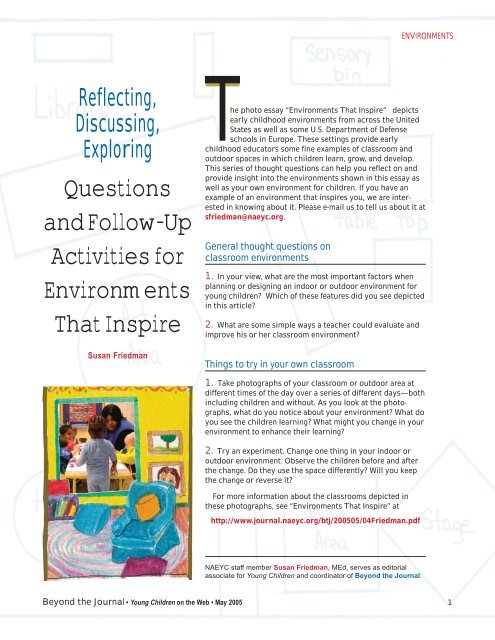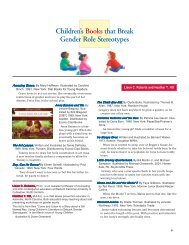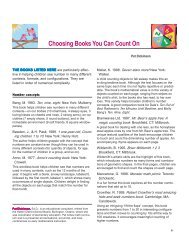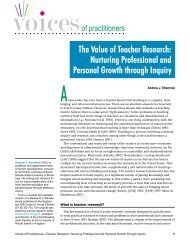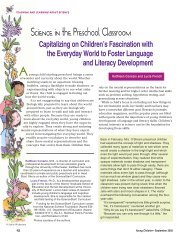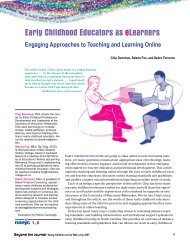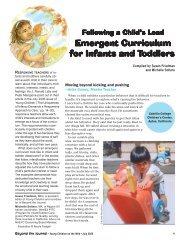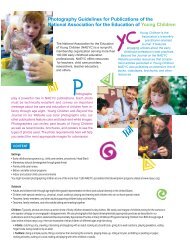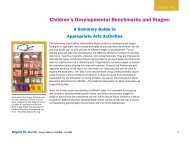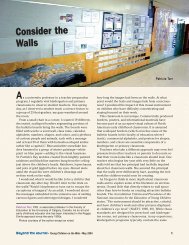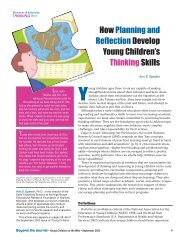Questions and Follow-Up Activities for Environments That Inspire
Questions and Follow-Up Activities for Environments That Inspire
Questions and Follow-Up Activities for Environments That Inspire
You also want an ePaper? Increase the reach of your titles
YUMPU automatically turns print PDFs into web optimized ePapers that Google loves.
Reflecting,<br />
Discussing,<br />
Exploring<br />
<strong>Questions</strong><br />
<strong>and</strong> <strong>Follow</strong>-<strong>Up</strong><br />
<strong>Activities</strong> <strong>for</strong><br />
<strong>Environments</strong><br />
<strong>That</strong> <strong>Inspire</strong><br />
Susan Friedman<br />
ENVIRONMENTS<br />
The photo essay “<strong>Environments</strong> <strong>That</strong> <strong>Inspire</strong>” depicts<br />
early childhood environments from across the United<br />
States as well as some U.S. Department of Defense<br />
schools in Europe. These settings provide early<br />
childhood educators some fine examples of classroom <strong>and</strong><br />
outdoor spaces in which children learn, grow, <strong>and</strong> develop.<br />
This series of thought questions can help you reflect on <strong>and</strong><br />
provide insight into the environments shown in this essay as<br />
well as your own environment <strong>for</strong> children. If you have an<br />
example of an environment that inspires you, we are interested<br />
in knowing about it. Please e-mail us to tell us about it at<br />
sfriedman@naeyc.org.<br />
General thought questions on<br />
classroom environments<br />
1. In your view, what are the most important factors when<br />
planning or designing an indoor or outdoor environment <strong>for</strong><br />
young children? Which of these features did you see depicted<br />
in this article?<br />
2. What are some simple ways a teacher could evaluate <strong>and</strong><br />
improve his or her classroom environment?<br />
Things to try in your own classroom<br />
1. Take photographs of your classroom or outdoor area at<br />
different times of the day over a series of different days—both<br />
including children <strong>and</strong> without. As you look at the photographs,<br />
what do you notice about your environment? What do<br />
you see the children learning? What might you change in your<br />
environment to enhance their learning?<br />
2. Try an experiment. Change one thing in your indoor or<br />
outdoor environment. Observe the children be<strong>for</strong>e <strong>and</strong> after<br />
the change. Do they use the space differently? Will you keep<br />
the change or reverse it?<br />
For more in<strong>for</strong>mation about the classrooms depicted in<br />
these photographs, see “<strong>Environments</strong> <strong>That</strong> <strong>Inspire</strong>” at<br />
http://www.journal.naeyc.org/btj/200505/04Friedman.pdf<br />
NAEYC staff member Susan Friedman, MEd, serves as editorial<br />
associate <strong>for</strong> Young Children <strong>and</strong> coordinator of Beyond the Journal.<br />
Beyond the Journal • Young Children on the Web May 2005 1
© Bonnie Blagojevic<br />
© St. Louis Reggio Collaborative<br />
Exp<strong>and</strong>ing on the article “<strong>Environments</strong> <strong>That</strong> <strong>Inspire</strong>”<br />
Examine the groups of photos that follow <strong>for</strong> ideas to create engaging<br />
places <strong>for</strong> children <strong>and</strong> their families.<br />
Places <strong>for</strong> exploring art<br />
Photos © Susan Friedman<br />
ENVIRONMENTS<br />
As you look at these environments where children can explore art<br />
materials, what similarities <strong>and</strong> differences do you see in the four<br />
spaces? Look at your own classroom <strong>and</strong> outdoor area in comparison.<br />
What do you notice about the spaces you have available <strong>for</strong> children to<br />
explore <strong>and</strong> experiment with art materials? What do you think contributes<br />
to a well-designed space <strong>for</strong> children to explore art materials?<br />
© NAEYC<br />
Beyond the Journal Young Children on the Web May 2005 2
© Jennifer Halley<br />
Early literacy—Books<br />
Photos © Donna King<br />
These photos depict<br />
children reading or interacting<br />
with books. What do the<br />
physical spaces say about<br />
children <strong>and</strong> books? When<br />
you reflect on your own<br />
classroom, what message<br />
do you think the book <strong>and</strong><br />
reading space arrangements<br />
send about reading?<br />
Early literacy—Writing<br />
© Stars & Stripes<br />
© NAEYC<br />
ENVIRONMENTS<br />
One of the photos<br />
features a writing area<br />
<strong>and</strong> mailboxes. What<br />
does this display say to<br />
the children about writing?<br />
How are the writing<br />
materials arranged in<br />
your classroom? What<br />
do you think your arrangement<br />
of the materials<br />
conveys to the<br />
children in your classroom<br />
about your expectations<br />
<strong>for</strong> writing?<br />
Beyond the Journal Young Children on the Web May 2005 3
© NAEYC<br />
Flexible space<br />
Outdoor spaces<br />
These photos show some unusual uses <strong>for</strong> the outdoor<br />
area. What are your thoughts on unusual materials, projects,<br />
or activities that can take place outdoors? How might<br />
children benefit from doing these activities outdoors?<br />
Look at the dramatic play area at<br />
Hilltop Children’s Center (above) <strong>and</strong><br />
the flexible boundary <strong>for</strong> infants at Fort<br />
Meade Child Development Center (left).<br />
Why do you think these two areas were<br />
designed with flexibility? How does the<br />
flexibility support children’s explorations<br />
<strong>and</strong> learning? Do you have a need<br />
<strong>for</strong> a flexible area within your classroom?<br />
What would you use it <strong>for</strong>?<br />
ENVIRONMENTS<br />
Beyond the Journal Young Children on the Web May 2005 4<br />
© Ann Pelo<br />
© Deb Curtis
© Beverly Erdmann<br />
Involving families<br />
Many teachers <strong>and</strong> administrators say that<br />
family involvement is an important part of<br />
their program. What ways do the spaces<br />
shown in these photos incorporate families<br />
into the environments? How do you do this in<br />
your program? Which methods do you find to<br />
be effective? How do families respond?<br />
© Donna King<br />
© NAEYC<br />
© Deb Curtis<br />
ENVIRONMENTS<br />
Beyond the Journal Young Children on the Web May 2005 5
Open-ended materials<br />
© Deb Curtis<br />
How do these spaces <strong>and</strong> materials support children’s<br />
open-ended exploration? What’s more important <strong>for</strong><br />
open-ended exploration: space? materials? both?<br />
ENVIRONMENTS<br />
Beyond the Journal Young Children on the Web May 2005 6
Places <strong>for</strong> exploring art Early literacy—<br />
Books<br />
Photos from (top right) Outdoor Nursery School, Chevy<br />
Chase, Maryl<strong>and</strong>; (top left) Indian Isl<strong>and</strong> School, Old<br />
Town, Maine; (bottom left) Clayton School’s Family Center,<br />
Clayton, Missouri; <strong>and</strong> (bottom right) Child Development<br />
Center II, Fort George G. Meade, Fort Meade, Maryl<strong>and</strong>.<br />
Flexible space<br />
Outdoor spaces<br />
Photos from (left) Outdoor Nursery<br />
School, Chevy Chase, Maryl<strong>and</strong>;<br />
<strong>and</strong> (right) Burlington Little School,<br />
Seattle, Washington.<br />
Photos from (left) Child<br />
Development Center III, Fort<br />
George G. Meade, Fort<br />
Meade, Maryl<strong>and</strong>; <strong>and</strong> (right)<br />
Hilltop Children’s Center,<br />
Seattle, Washington.<br />
Photos from<br />
(top right)<br />
Child DevelopmentCenter<br />
III, Fort<br />
George G.<br />
Meade, Fort Meade, Maryl<strong>and</strong>;<br />
(top left) Giessen Elementary<br />
School, Department of Defense<br />
Dependents Schools, Giessen,<br />
Germany; <strong>and</strong> (right) Vilseck Elementary<br />
School, Department of<br />
Defense Dependents Schools,<br />
Vilseck, Germany.<br />
Early literacy—writing<br />
Involving families<br />
Photos from<br />
Children First,<br />
Durham, North<br />
Carolina.<br />
ENVIRONMENTS<br />
Photos from (top) Child Development Center II,<br />
Fort George G. Meade, Fort Meade, Maryl<strong>and</strong>;<br />
(middle left) Illesheim Elementary School, Department<br />
of Defense Dependents Schools, Illesheim,<br />
Germany; (middle right) Martin Luther King Day<br />
Home Center, Seattle, Washington; <strong>and</strong> (bottom)<br />
Children First, Durham, North Carolina.<br />
Beyond the Journal Young Children on the Web May 2005 7
Copyright © 2005 by the National Association <strong>for</strong> the<br />
Education of Young Children. See Permissions <strong>and</strong><br />
Reprints online at<br />
http://www.journal.naeyc.org/about/permissions.asp<br />
Open ended materials<br />
Photos from (left) Burlington<br />
Little School, Seattle,<br />
Washington; (top right)<br />
Martin Luther King Day<br />
Home Center, Seattle,<br />
Washington; <strong>and</strong> (bottom<br />
right) Hilltop Children’s<br />
Center, Seattle, Washington.<br />
ENVIRONMENTS<br />
Beyond the Journal Young Children on the Web May 2005 8


